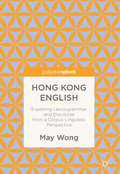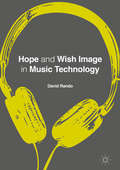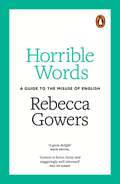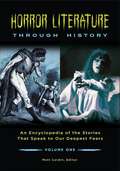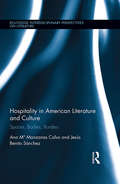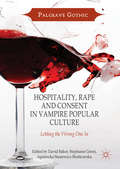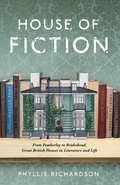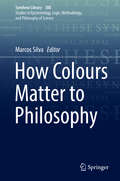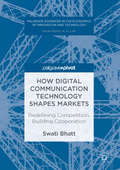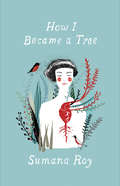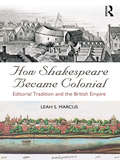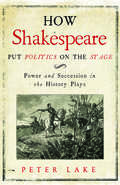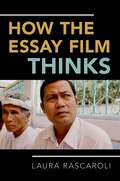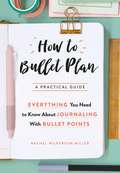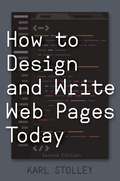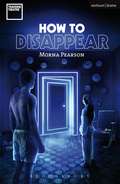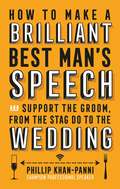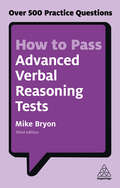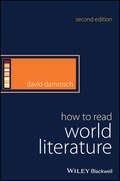- Table View
- List View
Hong Kong English: Exploring Lexicogrammar and Discourse from a Corpus-Linguistic Perspective
by May WongThis book systematically examines the linguistic features and socio-cultural issues of ‘Hong Kong English’. The author focuses on authentic data taken from the International Corpus of English (the Hong Kong component) and the Corpus of Global Web-based English to track the ways in which the English language in Hong Kong has been adapted by its users. She also analyses the emergence of new forms and structures in its grammar and discourse. While the phonetic and phonological aspects of this variety of English have been well documented, its grammatical peculiarities and social language use have been hitherto neglected. This book offers original insights into the grammatical and pragmatic/discoursal features of Hong Kong English and will therefore be of interest to those working in fields such as World Englishes and corpus linguistics.
Hope and Wish Image in Music Technology
by David P. RandoThis book proposes that new music technologies attract unconscious desires for socialism and collectivity, enabling millions of people living under capitalism to dream of repressed social alternatives. Grounded in the philosophical writings of Ernst Bloch and Walter Benjamin, the book examines file sharing technologies, streaming services, and media players, as well as their historical antecedents, such as the player piano, cassette tape, radio and compact disc, alongside interpretations of fiction, memoir, and albums. Through the concept of wish images—the unconscious hopes and desires for social alternatives that gather around new technologies—the book identifies the repressed pre- and post-capitalist urges that attend our music technologies. While these desires typically remain unconscious and tend to pass away not only unmet but also unrecognized, Hope and Wish Image in Music Technology attempts to bring wishes for social alternatives to the surface at an auspicious moment of technological transition.
Hope and Wish Image in Music Technology (PDF)
by David P. RandoThis book proposes that new music technologies attract unconscious desires for socialism and collectivity, enabling millions of people living under capitalism to dream of repressed social alternatives. Grounded in the philosophical writings of Ernst Bloch and Walter Benjamin, the book examines file sharing technologies, streaming services, and media players, as well as their historical antecedents, such as the player piano, cassette tape, radio and compact disc, alongside interpretations of fiction, memoir, and albums. Through the concept of wish images—the unconscious hopes and desires for social alternatives that gather around new technologies—the book identifies the repressed pre- and post-capitalist urges that attend our music technologies. While these desires typically remain unconscious and tend to pass away not only unmet but also unrecognized, Hope and Wish Image in Music Technology attempts to bring wishes for social alternatives to the surface at an auspicious moment of technological transition.
Horrible Words: A Guide to the Misuse of English
by Rebecca GowersNothing inflames the language gripers like a misplaced disinterested, an illogical irregardless, a hideous operationalisation. To purists these are 'howlers' and 'non-words', fit only for scorn. But in their rush to condemn such terms, are the naysayers missing something? In this provocative and hugely entertaining book, Rebecca Gowers throws light on a great array of horrible words, and shows how the diktats of the pedants are repeatedly based on misinformation, false reasoning and straight-up snobbery. The result is a brilliant work of history, a surreptitious introduction to linguistics, and a mischievous salute to the misusers of the language. It is also a bold manifesto asserting our common rights over English, even as it questions the true nature of style.
Horror Literature through History [2 volumes]: An Encyclopedia of the Stories That Speak to Our Deepest Fears [2 volumes]
by Editor Matt CardinThis two-volume set offers comprehensive coverage of horror literature that spans its deep history, dominant themes, significant works, and major authors, such as Stephen King, Edgar Allan Poe, and Anne Rice, as well as lesser-known horror writers.Many of today's horror story fans—who appreciate horror through movies, television, video games, graphic novels, and other forms—probably don't realize that horror literature is not only one of the most popular types of literature but one of the oldest. People have always been mesmerized by stories that speak to their deepest fears. Horror Literature through History shows 21st-century horror fans the literary sources of their favorite entertainment and the rich intrinsic value of horror literature in its own right. Through profiles of major authors, critical analyses of important works, and overview essays focused on horror during particular periods as well as on related issues such as religion, apocalypticism, social criticism, and gender, readers will discover the fascinating early roots and evolution of horror writings as well as the reciprocal influence of horror literature and horror cinema.This unique two-volume reference set provides wide coverage that is current and compelling to modern readers—who are of course also eager consumers of entertainment. In the first section, overview essays on horror during different historical periods situate works of horror literature within the social, cultural, historical, and intellectual currents of their respective eras, creating a seamless narrative of the genre's evolution from ancient times to the present. The second section demonstrates how otherwise unrelated works of horror have influenced each other, how horror subgenres have evolved, and how a broad range of topics within horror—such as ghosts, vampires, religion, and gender roles—have been handled across time. The set also provides alphabetically arranged reference entries on authors, works, and specialized topics that enable readers to zero in on information and concepts presented in the other sections.
Hospitality in American Literature and Culture: Spaces, Bodies, Borders (Routledge Transnational Perspectives on American Literature)
by Ana Maria Manzanas Calvo Jesús Benito SanchezThis volume examines hospitality in American immigrant literature and culture, situating this ancient virtue at the crossroads of space and border theory, and exploring the relationship among the intersecting themes of migration, citizenship, identity formation, and spatiality. Assessing the conditions, duration, and shifting roles of hosts and guests in the United States, the book concentrates on the ways the US administers protocols of belonging and non-belonging, and distinguishes between those who can feel at home from those who will always be outside the body politic, even if they were the original "hosts." The volume opens with a genealogy of hospitality through a focus on its sites, from its origins in the Bible, to its national and post-national renditions in contemporary American literature and culture. The authors explore recent representations of immigrant spatiality, from the space of the body in Spielberg’s The Terminal and Frears’s Dirty Pretty Things, to the different ways in which immigrants are incorporated into the United States in Alex Rivera’s Sleep Dealer, Karen T. Yamashita’s I Hotel, Junot Díaz’s "Invierno," and Ernesto Quiñonez’s Chango’s Fire, concluding with the spectrality of the immigrant body in George Saunders’ "The Semplica Girl Diaries." Timely and imperative in light of the legacies of colonialism, and the realities of modern-day globalization, this book will be of value to specialists in post-colonialism; American Studies; immigration, diaspora, and border studies; and critical race and gender studies for its innovative approaches to media and literary texts.
Hospitality in American Literature and Culture: Spaces, Bodies, Borders (Routledge Transnational Perspectives on American Literature)
by Ana Maria Manzanas Calvo Jesús Benito SanchezThis volume examines hospitality in American immigrant literature and culture, situating this ancient virtue at the crossroads of space and border theory, and exploring the relationship among the intersecting themes of migration, citizenship, identity formation, and spatiality. Assessing the conditions, duration, and shifting roles of hosts and guests in the United States, the book concentrates on the ways the US administers protocols of belonging and non-belonging, and distinguishes between those who can feel at home from those who will always be outside the body politic, even if they were the original "hosts." The volume opens with a genealogy of hospitality through a focus on its sites, from its origins in the Bible, to its national and post-national renditions in contemporary American literature and culture. The authors explore recent representations of immigrant spatiality, from the space of the body in Spielberg’s The Terminal and Frears’s Dirty Pretty Things, to the different ways in which immigrants are incorporated into the United States in Alex Rivera’s Sleep Dealer, Karen T. Yamashita’s I Hotel, Junot Díaz’s "Invierno," and Ernesto Quiñonez’s Chango’s Fire, concluding with the spectrality of the immigrant body in George Saunders’ "The Semplica Girl Diaries." Timely and imperative in light of the legacies of colonialism, and the realities of modern-day globalization, this book will be of value to specialists in post-colonialism; American Studies; immigration, diaspora, and border studies; and critical race and gender studies for its innovative approaches to media and literary texts.
Hospitality, Rape and Consent in Vampire Popular Culture
by David Baker Stephanie Green Agnieszka Stasiewicz-BieńkowskaThis unique study explores the vampire as host and guest, captor and hostage: a perfect lover and force of seductive predation. From Dracula and Carmilla, to True Blood and The Originals, the figure of the vampire embodies taboos and desires about hospitality, rape and consent. The first section welcomes the reader into ominous spaces of home, examining the vampire through concepts of hospitality and power, the metaphor of threshold, and the blurred boundaries between visitation, invasion and confinement. Section two reflects upon the historical development of vampire narratives and the monster as oppressed, alienated Other. Section three discusses cultural anxieties of youth, (im)maturity, childhood agency, abuse and the age of consent. The final section addresses vampire as intimate partner, mapping boundaries between invitation, passion and coercion. With its fresh insight into vampire genre, this book will appeal to academics, students and general public alike.
The House of Fiction: From Pemberley to Brideshead, Great British Houses in Literature and Life
by Phyllis RichardsonHouses in literature have captured readers’ imaginations for centuries, from Gothic castles to Georgian stately homes, Bloomsbury townhouses and high-rise penthouses. Step on to a tour of real and imagined houses that great English writers have used to reflect the themes of their novels… houses that became like characters themselves, embodiments of the social and historical currents of their time.Phyllis Richardson takes us on a journey through history to discover how authors’ personal experiences in their homes helped to shape the imaginative dwellings that have become icons of English literature:Virginia Woolf’s love of Talland House in Cornwall is palpable in To the Lighthouse, just as London’s Bloomsbury is ever-present in Mrs Dalloway. E.M. Forster’s childhood home at Rook’s Nest mirrors the idyllic charm of Howards End. Evelyn Waugh plotted Charles Ryder’s return to Brideshead while a guest at Madresfield. Jane Austen was no stranger to a manor house or a good ballroom. And Horace Walpole’s ‘little Gothic castle’ in Twickenham inspired him to write the first English Gothic novel, The Castle of Otranto.But the English country house, from the idyllic to the unloved, is also viewed through a modern lens – Kazuo Ishiguro’s Darlington Hall, Ian McEwan’s Tallis House, Alan Hollinghurts’s Two Acres.Using historic sources, authors’ biographies, letters, news accounts, and the novels themselves, The House of Fiction presents some of the most influential houses in Britain through the stories they inspired, while offering candid glimpses of the writers who brought them to life.
How Colours Matter to Philosophy (Synthese Library #388)
by Marcos SilvaThis edited volume explores the different and seminal ways colours matter to philosophy. Each chapter provides an insightful analysis of one or more cases in which colours raise philosophical problems in different areas and periods of philosophy. This historically informed discussion examines both logical and linguistic aspects, covering such areas as the mind, aesthetics and the foundations of mathematics. The international contributors look at traditional epistemological and metaphysical issues on the subjectivity and objectivity of colours. In addition, they also assess phenomenological problems typical of the continental tradition and contemporary problems in the philosophy of mind. The chapters include coverage of such topics as Newton’s and Goethe’s theory of light and colours, how primary qualities are qualitative and colours are primary, explaining colour phenomenology, and colour in cognition, language and philosophy. "This book beautifully prepares the ground for the next steps in our research on and philosophising about colour" Daniel D. Hutto (University of Wollongong)"It is not an overstatement to say that How Colours to Philosophy is a ground breaking publication" Mazviita Chirimuuta (University of Pittsburgh)"Anyone interested in philosophical issues about color will find it highly stimulating." Martine Nida-Rümelin (Université de Fribourg)"The high quality papers included in this anthology succeed admirably in enriching current philosophical thinking about colour” Erik Myin (University of Antwerp)“This is certainly the most complete collection of philosophical essays on colours ever published” André Leclerc (University of Brasília)“All in all this collections represents a new milestone in the ongoing philosophical debate on colours and colour expressions” Ingolf Max (University of Leipzig)
How Digital Communication Technology Shapes Markets: Redefining Competition, Building Cooperation
by Swati BhattThis Palgrave Pivot explores how communication technology such as the Internet has changed the nature of trade, focusing especially on economy-wide reductions in company size (granularity) and the role of retailers (disintermediation). By increasing access to comparative data, influencing conceptions of time, and reducing the number of intermediaries between creator and consumer, technological connectivity is changing the very definition of competition. In the new network economy, disintermediation and granularity are turning cooperative information gathering and sharing into a vital market institution.To exemplify the effects of communication technology, Bhatt focuses on two markets with particularly powerful effects on the economy: labor and education, and CIME (communication, information services, media, and entertainment). Mobile connectivity is radically changing the extent, capabilities, and operations of these markets, both in terms of the services they provide and how they interact with consumers. Bhatt also explores how these benefits intersect with new concerns about privacy and security when the line between public and private information is becoming ever more fluid.
How Digital Communication Technology Shapes Markets: Redefining Competition, Building Cooperation
by Swati BhattThis Palgrave Pivot explores how communication technology such as the Internet has changed the nature of trade, focusing especially on economy-wide reductions in company size (granularity) and the role of retailers (disintermediation). By increasing access to comparative data, influencing conceptions of time, and reducing the number of intermediaries between creator and consumer, technological connectivity is changing the very definition of competition. In the new network economy, disintermediation and granularity are turning cooperative information gathering and sharing into a vital market institution.To exemplify the effects of communication technology, Bhatt focuses on two markets with particularly powerful effects on the economy: labor and education, and CIME (communication, information services, media, and entertainment). Mobile connectivity is radically changing the extent, capabilities, and operations of these markets, both in terms of the services they provide and how they interact with consumers. Bhatt also explores how these benefits intersect with new concerns about privacy and security when the line between public and private information is becoming ever more fluid.
How I Became a Tree
by Sumana RoyAn exquisite, lovingly crafted meditation on plants, trees, and our place in the natural world, in the tradition of Robin Wall Kimmerer’s Braiding Sweetgrass and Annie Dillard’s Pilgrim at Tinker Creek “I was tired of speed. I wanted to live tree time.” So writes Sumana Roy at the start of How I Became a Tree, her captivating, adventurous, and self-reflective vision of what it means to be human in the natural world. Drawn to trees’ wisdom, their nonviolent way of being, their ability to cope with loneliness and pain, Roy movingly explores the lessons that writers, painters, photographers, scientists, and spiritual figures have gleaned through their engagement with trees—from Rabindranath Tagore to Tomas Tranströmer, Ovid to Octavio Paz, William Shakespeare to Margaret Atwood. Her stunning meditations on forests, plant life, time, self, and the exhaustion of being human evoke the spacious, relaxed rhythms of the trees themselves. Hailed upon its original publication in India as “a love song to plants and trees” and “an ode toall that is unnoticed, ill, neglected, and yet resilient,” How I Became a Tree blends literary history, theology, philosophy, botany, and more, and ultimately prompts readers to slow down and to imagine a reenchanted world in which humans live more like trees.
How Shakespeare Became Colonial: Editorial Tradition and the British Empire
by Leah S. MarcusIn this fascinating book, Leah S. Marcus argues that the colonial context in which Shakespeare was edited and disseminated during the heyday of the British Empire has left a mark on Shakespeare’s texts to the present day. How Shakespeare Became Colonial offers a unique and engaging argument, including: A brief history of the colonial importance of editing Shakespeare; The colonially inflected racism that hides behind the editing of Othello; The editing of female characters – colonization as sexual conquest; The significance of editions that were specifically created for schools in India during British colonial rule. Marcus traces important ways in which the colonial enterprise of setting forth the best possible Shakespeare for world consumption has continued to be visible in the recent treatment of his playtexts today, despite our belief that we are global or postcolonial in approach.
How Shakespeare Became Colonial: Editorial Tradition and the British Empire
by Leah S. MarcusIn this fascinating book, Leah S. Marcus argues that the colonial context in which Shakespeare was edited and disseminated during the heyday of the British Empire has left a mark on Shakespeare’s texts to the present day. How Shakespeare Became Colonial offers a unique and engaging argument, including: A brief history of the colonial importance of editing Shakespeare; The colonially inflected racism that hides behind the editing of Othello; The editing of female characters – colonization as sexual conquest; The significance of editions that were specifically created for schools in India during British colonial rule. Marcus traces important ways in which the colonial enterprise of setting forth the best possible Shakespeare for world consumption has continued to be visible in the recent treatment of his playtexts today, despite our belief that we are global or postcolonial in approach.
How Shakespeare Put Politics on the Stage: Power and Succession in the History Plays
by Peter LakeA masterful, highly engaging analysis of how Shakespeare’s plays intersected with the politics and culture of Elizabethan England With an ageing, childless monarch, lingering divisions due to the Reformation, and the threat of foreign enemies, Shakespeare’s England was fraught with unparalleled anxiety and complicated problems. In this monumental work, Peter Lake reveals, more than any previous critic, the extent to which Shakespeare’s plays speak to the depth and sophistication of Elizabethan political culture and the Elizabethan imagination. Lake reveals the complex ways in which Shakespeare’s major plays engaged with the events of his day, particularly regarding the uncertain royal succession, theological and doctrinal debates, and virtue and virtù in politics. Through his plays, Lake demonstrates, Shakespeare was boldly in conversation with his audience about a range of contemporary issues. This remarkable literary and historical analysis pulls the curtain back on what Shakespeare was really telling his audience and what his plays tell us today about the times in which they were written.
How the Essay Film Thinks
by Laura RascaroliThis book offers a novel understanding of the epistemological strategies that are mobilized by the essay film, and of where and how such strategies operate. Against the backdrop of Adorno's discussion of the essay form's anachronistic, anti-systematic and disjunctive mode of resistance, and capitalizing on the centrality of the interstice in Deleuze's understanding of the cinema as image of thought, the book discusses the essay film as future philosophy-as a contrarian, political cinema whose argumentation engages with us in a space beyond the verbal. A diverse range of case studies discloses how the essay film can be a medium of thought on the basis of its dialectic use of audiovisual interstitiality. The book shows how the essay film's disjunctive method comes to be realized at the level of medium, montage, genre, temporality, sound, narration, and framing-all of these emerging as interstitial spaces of intelligence that illustrate how essayistic meaning can be sustained, often in contexts of political, historical or cultural extremity. The essayistic urge is not to be identified with a fixed generic form, but is rather situated within processes of filmic thinking that thrive in gaps.
How to Bullet Plan: Everything You Need to Know About Journaling with Bullet Points
by Rachel Wilkerson MillerSo what is a bullet journal? It’s a planner, to-do list and diary that will help you get your life together!This fun, practical guide shows you how to start and keep a bullet journal: a single notebook in which you write down all the things that you want to remember, or need to do, or you’ve already done – from every aspect of your life: work, home, relationships and hobbies.With colourful illustrations and easy tips to get you started, early adopter Rachel Wilkerson Miller explains how to make a bullet journal work for you – whether you want to create something simple or elaborate. Ideas for content include:- Lists of your to-dos and to-don’ts- Symbols that will make your lists efficient and effective- Calendars to plan your day, week, month or year- Trackers for your habits and goals (think health, money, travel)- Stationery such as washi tape, book darts and more!The phenomenon that is bullet journaling has led to thousands of journalers sharing their work on Pinterest, Instagram and Facebook. In How To Bullet Plan, Buzzfeed editor Rachel Wilkerson Miller tells you everything you need to know to start your own.
How to Design and Write Web Pages Today
by Karl StolleyThis unique guidebook lays the foundations of contemporary mobile-first, responsive web design, offering writers, designers, and those who teach them a complete and up-to-date approach to web design.Are you looking to learn web design the right way? Not by using an off-the-shelf software package, but by creating customized sites in a way that gives you full control? This guide provides that ability even if you have no previous coding skills or experience.One of the critical challenges of modern web design is being able to write for the mobile web to reach those increasingly mobile-connected users. How to Design and Write Web Pages Today addresses this key objective while also explaining how to deliver improved experiences for users of desktop-style devices based on the constraints and challenges of mobile design. This user-friendly tutorial begins with background information to enable a better understanding of the web and its purpose and function as well as how to generate material for a website. Readers then learn about the three overarching concerns in the short- and long-term viability and usefulness of websites: accessibility, usability, and sustainability. Key technologies and techniques for web design—such as the HTML and CSS languages to the conceptual foundations of grid-based design—are next, followed by a thorough explanation of how to publish a site on the open web, from creating a viable site architecture to automating the publishing of content to the open web.
How to Design and Write Web Pages Today
by Karl StolleyThis unique guidebook lays the foundations of contemporary mobile-first, responsive web design, offering writers, designers, and those who teach them a complete and up-to-date approach to web design.Are you looking to learn web design the right way? Not by using an off-the-shelf software package, but by creating customized sites in a way that gives you full control? This guide provides that ability even if you have no previous coding skills or experience.One of the critical challenges of modern web design is being able to write for the mobile web to reach those increasingly mobile-connected users. How to Design and Write Web Pages Today addresses this key objective while also explaining how to deliver improved experiences for users of desktop-style devices based on the constraints and challenges of mobile design. This user-friendly tutorial begins with background information to enable a better understanding of the web and its purpose and function as well as how to generate material for a website. Readers then learn about the three overarching concerns in the short- and long-term viability and usefulness of websites: accessibility, usability, and sustainability. Key technologies and techniques for web design—such as the HTML and CSS languages to the conceptual foundations of grid-based design—are next, followed by a thorough explanation of how to publish a site on the open web, from creating a viable site architecture to automating the publishing of content to the open web.
How to Disappear (Modern Plays)
by Morna PearsonWhen Helen Daniels from Neighbours died, Robert shut his door on the world. And he's not opened it since. Now his only connection to the outside world is through his younger sister Isla, who looks after them both whilst their father is away in Ibiza on 'business'.With only a strange menagerie of creatures (including an iguana called Scott and a corn snake called Charlene) to keep them company, each day looks pretty much the same as the last – until their quiet lives are interrupted by a visit from Jessica, a benefit assessor, determined to prove that Robert is fit for work.But Jessica soon realises that one size certainly does not fit all, as she suddenly stumbles across a secret about Robert that catapults her head first into a universe of infinite possibilities.Merging biting social commentary and fantasy in unexpected ways, How to Disappear is a pitch-black comedy which gives a voice to those who often go unheard.
How To Make a Brilliant Best Man's Speech: and support the groom, from the stag do to the wedding (Tom Thorne Novels #557)
by Phillip Khan-PanniHow to make a great, best man's speech - and a guide to being a great best man.In this book Phillip Khan-Panni uses his expertise as a champion professional speaker to help the best man with the terrifying prospect of writing and delivering The Speech.He guides you on the vital preparation of your speech and tells you how to use stories, jokes and quotations that will lift it well above the bare necessities. With the author`s help and his professional tips and techniques, you will be able to make a really entertaining and moving speech that will be remembered for a long time to come. You might even enjoy making it as much as the guests do hearing it!There are also checklists and further advice to help you organise the whole occasion so that the big day honours the groom and his bride and thoroughly impresses their friends and relations
How to Pass Advanced Verbal Reasoning Tests: Over 500 Practice Questions (3rd edition)
by Mike BryonContaining the largest bank of test questions on the market, How to Pass Advanced Verbal Reasoning Tests provides advice, practice and exercises to help you prepare for the rigorous tests used by employers, helping you to build up speed, accuracy and confidence. Testing expert Mike Bryon offers practice on a range of areas, including: - English usage - Written assessments - Presentations - Group exercises - Assessment centres Including four timed realistic tests with interpretations of your score, How to Pass Advanced Verbal Reasoning Tests covers word links, word swaps, sentence sequence, decision analysis, reading comprehension as well as critical reasoning, giving you everything you need to boost your ability and face the challenge head on.
How to Read World Literature (How to Study Literature #7)
by David DamroschThe new edition of this highly popular guide, How to Read World Literature, addresses the unique challenges and joys faced when approaching the literature of other cultures and eras. Fully revised to address important developments in World Literature, and generously expanded with new material, this second edition covers a wide variety of genres – from lyric and epic poetry to drama and prose fiction – and discusses how each form has been used in different eras and cultures. An ideal introduction for those new to the study of World Literature, as well as beginners to ancient and foreign literature, this book offers a variety of "modes of entry" to reading these texts. The author, a leading authority in the field, draws on years of teaching experience to provide readers with ways of thinking creatively and systematically about key issues, such as reading across time and cultures, reading works in translation, emerging global perspectives, postcolonialism, orality and literacy, and more. Accessible and enlightening, offers readers the tools to navigate works as varied as Homer, Sophocles, Kalidasa, Du Fu, Dante, Murasaki, Moliere, Kafka, Wole Soyinka, and Derek Walcott Fully revised and expanded to reflect the changing face of the study of World Literature, especially in the English-speaking world Now includes more major authors featured in the undergraduate World Literature syllabus covered within a fuller critical context Features an entirely new chapter on the relationship between World Literature and postcolonial literature How to Read World Literature, Second Edition is an excellent text for undergraduate and postgraduate courses in World Literature. It is also a fascinating and informative read for all readers with an interest in foreign and ancient literature and the history of civilization.
How to Read World Literature (How to Study Literature)
by David DamroschThe new edition of this highly popular guide, How to Read World Literature, addresses the unique challenges and joys faced when approaching the literature of other cultures and eras. Fully revised to address important developments in World Literature, and generously expanded with new material, this second edition covers a wide variety of genres – from lyric and epic poetry to drama and prose fiction – and discusses how each form has been used in different eras and cultures. An ideal introduction for those new to the study of World Literature, as well as beginners to ancient and foreign literature, this book offers a variety of "modes of entry" to reading these texts. The author, a leading authority in the field, draws on years of teaching experience to provide readers with ways of thinking creatively and systematically about key issues, such as reading across time and cultures, reading works in translation, emerging global perspectives, postcolonialism, orality and literacy, and more. Accessible and enlightening, offers readers the tools to navigate works as varied as Homer, Sophocles, Kalidasa, Du Fu, Dante, Murasaki, Moliere, Kafka, Wole Soyinka, and Derek Walcott Fully revised and expanded to reflect the changing face of the study of World Literature, especially in the English-speaking world Now includes more major authors featured in the undergraduate World Literature syllabus covered within a fuller critical context Features an entirely new chapter on the relationship between World Literature and postcolonial literature How to Read World Literature, Second Edition is an excellent text for undergraduate and postgraduate courses in World Literature. It is also a fascinating and informative read for all readers with an interest in foreign and ancient literature and the history of civilization.
